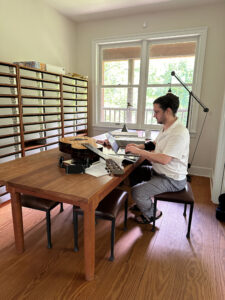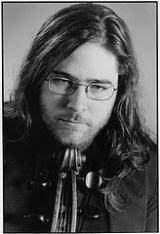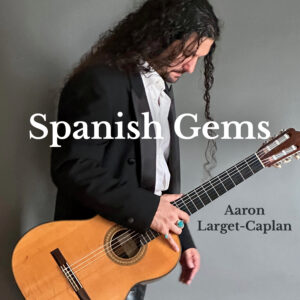In early July, I was invited to spend a few days at the John Cage Trust. Located a couple hours north of New York city in Red Hook, New York, it is housed at the wonderfully beautiful Wilson House at Bard College.
The JC Trust was established in 1993 as a not-for-profit institution whose mission is to gather together, organize, preserve, disseminate, and generally further the work of the late American composer, John Cage. It moved to Bard College about 17 years ago. Click here to read more about the JC Trust and a gallery of photos is at the bottom.
Brief Background:
I started transcribing the music of John Cage for guitar in 2013, beginning with the piano part of Six Melodies for violin and piano. My arrangement, premiered at the Boston Conservatory that year, turned out to be the first arrangement for guitar of Cage’s music to be published with the expressed approval of the JC Trust, being issued by Edition Peters in 2015.
I didn’t know it then, but I quickly descended into a rabbit hole of musical arranging magic, a collection of his early and mid-career solos in Piano Music Arranged for Guitar (2018), as well as the prepared piano work, Bacchanale (2022), for two prepared guitars. 
An album of all of the above works came out in 2018 on the UK label Stone Records under the title, John. Cage. Guitar.
Since the release of the album, I have been awarded two residencies focused on continuing my exploration of the music of John Cage. The first was in January 2020, at the Banff Centre for Arts and Creativity in Alberta, Canada, and the second was in 2022, a Community Artist Residency at the Kirkland Arts Center in Clinton, New York.
It was an amazing honor to be invited by John Cage Trust Director, Laura Kuhn for a third.
My Work:
I came to Bard College with the intent of researching and presenting a couple of Cage’s later works inspired by Erik Satie: Perpetual Tango and Swinging.
From the description of Perpetual Tango on the John Cage website:
Cage maintained the rhythm of Satie’s work, but omitted and lengthened certain of its notes, a process similar to that used in the composition of his Cheap Imitation. Pitches are unspecified, but indications for registers are notated and directions are given for the sounding of single notes or intervals.
While at the residency, I also arranged Satie’s original works from “Sports et Divertissements” from which the two works are based, Le Tango Perpétuel and La Balançoire.
These works are fascinating!
Satie wrote 21 short works, each with a different Sport or Entertainment title. Each work also includes an original poem written above the music. Curious on whether the performer should speak the text while playing, I did find a note in the Virgil Thompson edition stating that Satie wanted the poems read before each piece was to be played. 
I admit to being slightly disappointed by that, but I may experiment and perform the works with the text, in French of course, on a repeat. Maybe it’ll work and Satie doesn’t like it, well…he can complain to me.
The Cage pieces do include a poem, a “mesostic” (similar to acrostic, but led by middle rather than initial letters), with each one spelling ERIK SATIE, though they are not presented in the usual vertical manner.
Cage did begin a third work, Hunting, based on Satie’s, but it was not completed. Seeing the manuscript with all of his notes both for the music and the mesostic, was a gift I will cherish.
It should be noted, that Virgil Thompson translates Satie’s musical direction of Modéré et très ennuyé as Moderate and Agitated. I disagree with this and consider Moderate and Very Boring to be the proper musical directions.
The Concert
As the two works by Cage and Satie are both very short, I decided to create a program around arrangements by composers who Cage knew and who were influenced by him. On Saturday July 13, I presented “Arranging Influence.”
PROGRAM: Music of John Cage, Alan Hovhaness, Erik Satie, Toru Takemitsu, and Larget-Caplan*
- Larget-Caplan – sweet nuance
- Satie – Le Tango Perpétuel
- Cage – Perpetual Tango
- Satie – La Balançoire
- Cage – Swinging
- Takemitsu – Over the Rainbow & Summertime (arrangements)
- Hovhaness – Mystic Flute, Op. 22
- Cage – Chess Pieces
- Cage – In a Landscape
- Larget-Caplan – honey cadence & moving still
*All original works except the Takemitsu performed in arrangements by Larget-Caplan.
I found the program to be quite rewarding. Special note was made of Chess Pieces, a work I have only performed live three times, as many had not heard it performed on guitar. The music literally comes from a painting Cage did on a chess theme for his friend and chess partner Marcel Duchamp. The music written across the painted chess board was not transcribed until 2005 by Margaret Leng Tan. Though written in a grand staff, it does not designate an instrument or tempo. It is a perfect work for guitar, asking for a variety of colors and textures, and only a couple of spots seem not to be written for the instrument. My arrangement is in CAGE: Piano Music For Guitar.
For a future presentation of the Satie & Cage works, I would present both Satie works and then both Cage works.
It was a great pleasure to meet Bard College composer Kyle Gann and John Cage fan Ralph Benko.
Presenting my latest published arrangement, Mystic Flute by Alan Hovhaness brought me great pleasure, as I just gave the east coast premiere of his work for choir & guitar ‘How Lovely Are Thy Dwellings.’ Of Hovhaness, Cage wrote: “Alan Hovhaness is like a ‘music tree’ that produces music as trees produce fruit” – NY Times.
The Toru Takemitsu arrangements were a surprise to the listeners. Many musicians outside of guitar do not know that Takemitsu taught himself guitar and wrote a number of solo and chamber works, including a concerto, which Hovhaness did as well. The Harold Arlen and George Gershwin arrangements are two of my favorites and are gems for the instrument.
My solos sweet nuance and moving still are directly influenced by John Cage. I approached each with a desire to create works that take the listener out of time and celebrate the colors of the guitar.
Conclusion
I returned home inspired to continue working on my arrangements and to explore further into Cage’s music and life.
I am grateful to JCT director Laura Kuhn for her hospitality. The house sits amongst the incredible landscape of the Hudson Valley, and the grounds of Bard College are immaculate. When one is in the area, I recommend a walk on Poet’s Path; it is incredibly inspiring. 
Laura Kuhn is retiring from her position as Director of the John Cage Trust, and I wish her well on her new musical adventures. She and the JCT board have created an excellent space to celebrate and learn about the life, music, writings, and art of one of America’s most important 20th century composers.
I do hope my work and sharing of Cage’s music opens the eyes and ears of more guitarists and general listeners. There are many things Cage is known for and first and foremost it should be as a composer.
* The Cage and Hovhaness scores are published by Edition Peters and available worldwide online. Aaron’s compositions are published by the American Composers Alliance and recorded on honey cadence (Tiger Turn). The album John. Cage. Guitar. is on all streaming services and physical CDs are available via Amazon and online retailers. All scores and albums are also available via the Artist’s Bandcamp.











































